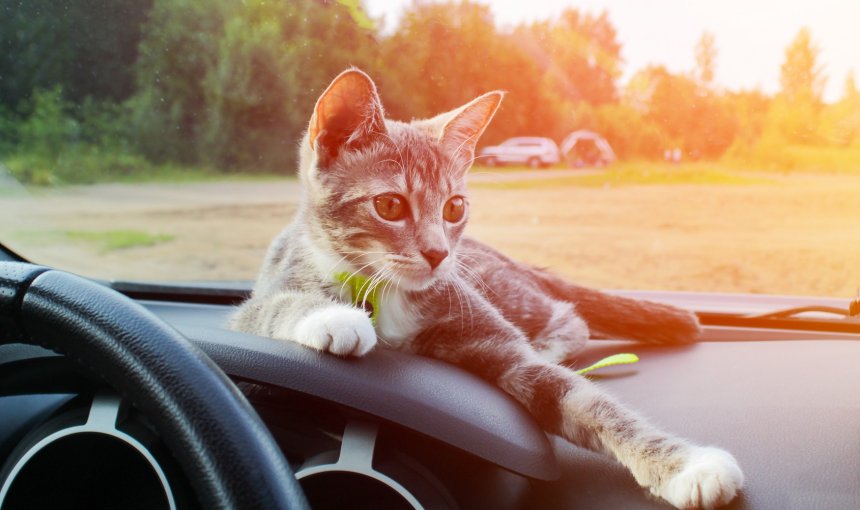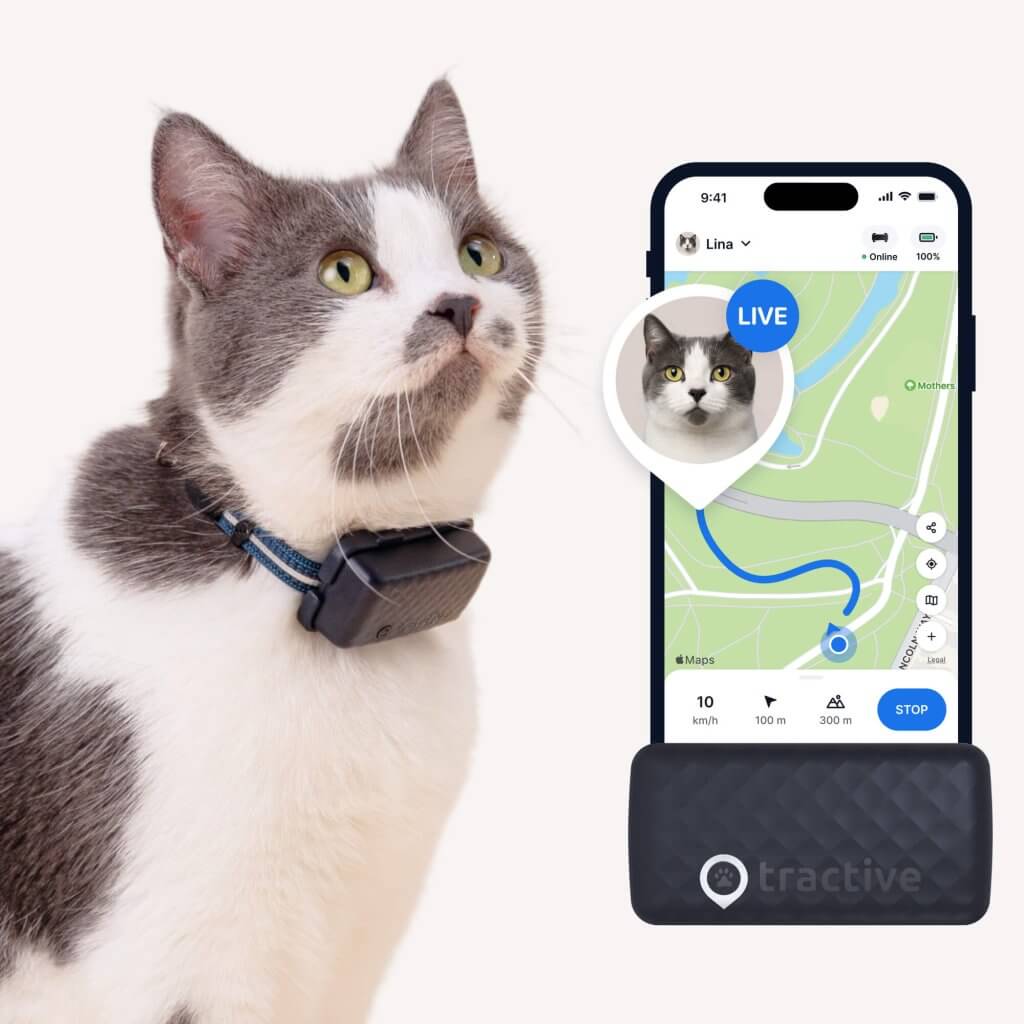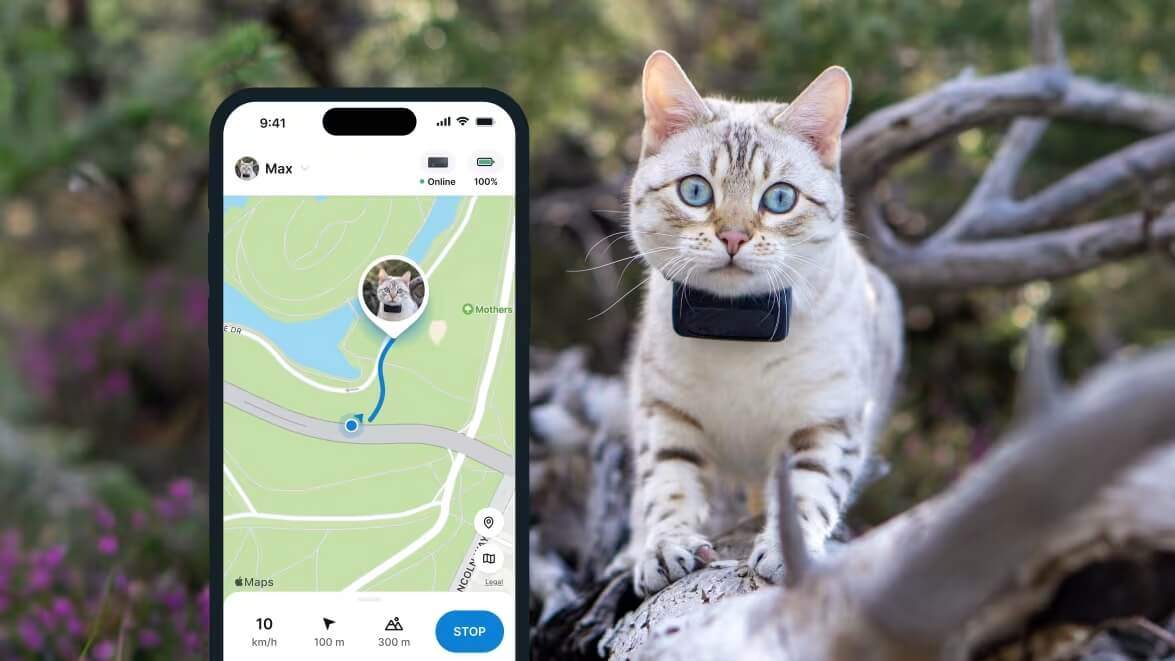How To Travel With A Cat: Tips For A Fun, Safe Road Journey
With a little planning and prep, traveling with your little buddy can be a safe and enjoyable adventure for both of you. Here's how to get started - and have a safe, fun road trip together!

Whether you’re going on vacation or moving with your cat(s) across the country, you wouldn’t be the first cat parent to ask yourself: how to travel with a cat? Here’s your go-to guide for everything you need to know. (Plus how to make sure you can always find them if they make a run for it.)
Key Takeaways
Preparation is crucial.
Before the trip, check your cat’s ID tags, microchip, and vaccinations. You should also choose a secure, properly-sized pet carrier and gradually get your cat used to it and the car.
Safety first during the journey.
Secure the carrier in the car, play calming music, avoid sudden movements, and never leave your cat alone in a hot vehicle.
Plan for rest stops and accommodations.
Use a portable litter box and book pet-friendly accommodations in advance.
Use a smart cat collar as a safety measure.
Your Tractive device comes with real-time GPS tracking and virtual fences to help prevent a cat from getting lost during the journey.

Find out where your cat spends their time.
Read more- Key Takeaways
- Traveling with a cat : Getting started
- What to do (and not do) when traveling with a cat by car
- Plan rest stops
- Traveling with a cat: Where to go ‘potty’
- When to give your cat food and water on a car trip
- Pick a cat-friendly place to stay
- What should I do if my cat gets carsick?
- Use a smart cat collar as an emergency measure
Traveling with a cat: Getting started
Before heading out:
- Check that your cat’s ID tags are securely affixed to their collar and that they include your current contact information.
- Consider having your cat microchipped by your veterinarian. Make sure your original contact information is up to date with the microchip registry.
- Contact your veterinarian to confirm that your beloved feline is current on all vaccinations.
⚠️ Just remember: a microchip alone won’t be able to actively track down your cat if they get lost – like escaping during a potty break or jumping out the car window. A microchip can only help a stranger identify your cat. (Which is bad news if you’re cat has now been picked up by a pet thief.)
It’s why cat parents around the world – just like you – are investing in a dedicated pet GPS tracker instead. So you can follow your cat’s every step in real-time – no matter how far they’re off roaming.

Track your cat wherever they go
Get real-time location information, wherever they go. Find out when they go somewhere they shouldn’t, with Virtual Fences. And discover their favorite spots with Territory.
Choose the right cat carrier for car travel
A pet carrier is a must when traveling in the car with your cat. You can choose one that’s hard-sided, soft-sided, opening from the side, or opening from the top. Deluxe soft-sided pet carriers have lots of pockets for stowing essential cat gear. Planning on an airplane trip? Go for an airline-approved pet carrier that you can use either in the car or on a flight.
💡 The carrier should give your kitty enough room to stand up and turn around. If your car ride is more than a few hours long, choose a pet carrier that has enough room for a portable litter box to fit inside. If you have more than one cat, keep each cat in their own separate pet carrier for the duration of your trip. You’ll reduce stress for everyone and prevent the two kitties from fighting. It’s OK to position the carriers so the cats can see each other.
Get your cat used to a travel carrier
About a month before your journey, place the open carrier near kitty’s favorite sleeping spot and tuck some cozy blankets inside. Toss a few treats near the doorway to encourage them to interact with it. Over time, your cat may end up using the carrier as a favorite snoozing spot.
Once your cat seems comfortable spending time in the carrier, try closing the carrier’s door for short time periods and see how your cat handles this. (Placing a few treats inside can sweeten the deal.)
Get your cat used to your car
The first time you place the carrier in the car, don’t drive anywhere at all! You want your little buddy to get used to this new, strange environment first. So here’s to get started:
- Load the pet carrier into the back seat (with kitty already inside), hop into the driver’s seat, and close all the doors. (Leave a window open for ventilation if it’s hot out.)
- Talk gently to your cat to keep them calm. If you can have another person in the car to interact with the cat in the back seat, that will be even better.
- Don’t start up the car or drive anywhere on this first try – that’s the next step!
Once your kitty seems comfortable being in a non-moving vehicle a few times, turn on the car and leave it parked. Of course, open the garage door when your car is running to avoid life-threatening carbon monoxide poisoning. Continue speaking gently to your cat, keep music low and offer treats as needed to keep kitty happy.
If your cat becomes agitated, turn off the car and head inside. You don’t want to turn this exercise into a battle. (Hint: you will lose!) Give your kitty lots of love once you’re in the house.
Where to place a cat carrier in the car
The safest place in the car for your cat is the back seat or on the floor behind the front passenger seat. Place the carrier in a secure location where it won’t slide around too much. Some carriers are equipped with clips for a seat belt to slide through. This provides additional security and will help your kitty feel safer during the ride. For a hard-sided plastic carrier, thread the seat belt through the handle.
Also make sure you avoid placing the pet carrier where it will be blasted by the heater or air conditioner. You want your kitty to be as comfortable as possible. Don’t forget to keep the cat carrier out of the path of an airbag if an accident should occur.
💡Most car seats slope backward. To create a level surface for the pet carrier to rest on, roll up a towel and place it under the back edge of the carrier.
Practice going on car rides
Once your cat is comfy hanging out in a non-moving but running vehicle, try driving a very short distance – maybe around the block at first. Having someone in the back seat to comfort and engage with your cat will help to keep your cat calm.
Introducing familiar scents into the carrier and the car may help your kitty to feel more relaxed. Tuck their favorite blanket (or a piece of it) in the carrier, or toss in one of your old t-shirts – unwashed, so it smells like you. Likewise, avoid using scented air fresheners in the car. Those scents may be overpowering for your kitty’s sensitive nose.
As your cat gets accustomed to short rides, gradually try longer rides. Your cat will become “king of the road” before you know it!
What to do (and not do) when traveling with a cat by car
| Do’s | Don’ts |
| – Play calm music. – Keep the car’s temperature similar to home. – Place a sheet or blanket atop your cat’s carrier for some peace and quiet. – Travel at a quiet time of day with as little traffic as possible. – Bring some of your cat’s favorite toys for the trip. | – Avoid playing loud music – Avoid making sharp turns or braking suddenly while your cat is in the car. Try to drive as smoothly and evenly as possible. – Don’t allow the pet carrier to slide along the seat. Keep the pet carrier buckled in place with the seat belt. – Don’t leave your cat alone in a hot car – ever! |
Plan rest stops
Highway rest areas are located along most interstates and state routes, and you can map these out in advance. If you aren’t on a road with a highway rest stop, travel plazas are a good alternative. These usually include gas stations, coffee shops, fast-food restaurants, and rest rooms. (Some even offer pet exercise areas.)
Also consider whether you can leave your cat in the car while you pop into a restroom or get a quick bite to eat. If it’s warm out, your cat could quickly become overheated if left inside a closed vehicle. So if possible, take the entire cat carrier into the rest stop with you. Or, if you have a human travel companion, take turns staying with the cat while the other uses the facilities.
⚠️ Do not open the carrier if your cat is unleashed and the car door is open. Besides getting hit by another car, your cat might end up running down the highway, hiding under another car (without being noticed) – or worse. So if you plan on taking your cat out of the carrier, do so ONLY if kitty can be leashed while the car doors are still closed.
Traveling with a cat: Where to go ‘potty’
If your cat is used to doing their business outdoors and is leash-trained, use a pet exercise area at a highway rest stop. Be sure to leash up your cat BEFORE opening the car door to the outside. If your cat is accustomed to going in a litter box, bring along a portable litter box and a bag of cat litter.
The litter box should be large enough for your cat, fit comfortably inside your car, easy to clean, waterproof, and ideally collapsible. Choose a low-dust, odor control, disposable cat litter to fill the portable litter box – preferably the same type that you use at home. Also, bring along a scoop and bags to collect used litter and dispose of it in a trash container. You might find it handy to sprinkle a litter box attractant in the portable litter box to make it more enticing for your cat.
When to give your cat food and water on a car trip
Many cats eat only once or twice a day, so it may not be necessary to feed your cat during a long car ride. However, kitties who are accustomed to snacking all day may need a few nibbles along the way. Intermittent snacking can also help cats who get motion sickness. Remember that eating stimulates the digestive system, so your cat may need to potty soon after eating. This may be a good reason for feeding your cat lightly on travel day.
💡Make sure to offer water to your cat at every pit stop. Cats normally drink very little water, so don’t be alarmed if your cat doesn’t drink much during the trip. Though if you’re concerned that your cat isn’t drinking enough water, offer some wet canned cat food, which has a higher moisture content than dry food.
Some travel food bowls can attach to the wire door of a plastic cat carrier. Or you can purchase a collapsible bowl that you pop open at mealtime. Bring enough of your cat’s preferred food to last for the entire trip.
Pick a cat-friendly place to stay
Not all hotels are pet-friendly. Even hotels that advertise themselves as pet-friendly may only have a few pet-friendly rooms. That’s why it’s important to book your lodging well in advance. When making your reservation, specify that you will have a cat with you and need a pet-friendly room. Find out what types of restrictions the hotel has, if any. Sneaking your pet into a non-pet-friendly hotel room isn’t a great idea – just don’t do it.
⚠️ Just be sure to keep in mind: a pet-friendly hotel room has probably been used by lots of other pets, including dogs and other cats. (That may or may not be on regular flea or parasite protection.) Make sure your cat is protected from parasites before you leave home.
Likewise, keep your kitty safely in the pet carrier as you unload and carry your luggage inside. Only when you are inside and have safely closed the building’s door should you allow your cat to exit the carrier. Set out the travel litter box and fill their travel bowls with fresh food and water. Give them time to sniff and rub against everything in their new temporary home.
What should I do if my cat gets carsick?
It’s possible that your cat could become extremely anxious or carsick on a long ride. Here are a few options for dealing with these situations.*
- Calming spray for cats
A few spritzes of a calming pheromone spray on a towel or blanket in your cat’s carrier could help your cat relax into the ride. - Catnip
A little catnip sprinkled into the carrier could distract your cat for a bit and keep them entertained. You might try catnip spray, also. - Calming treats
Specially-formulated cat treats can help to reduce nervousness in your furry friend. - Anti-anxiety jackets for cats
Also known as calming vests, these weighted jackets can help anxious pets to relax.
If your cat is prone to vomiting, urinating, or defecating during car trips, speak to your veterinarian. They may be able to offer medications that will make the trip more pleasant for you and your cat.
*Try these remedies out at home before you begin your road trip to determine if your cat can tolerate them.
Use a smart cat collar as an emergency measure
When you’re traveling by car, it’s easy for your cat to get anxious and potentially escape during rest stops or through open windows. But with a smart cat collar – like Tractive – you can have peace of mind knowing you can locate your cat at any given moment during your journey. Whether you’re in a busy parking lot or remote area, the tracker will help you monitor their whereabouts and ensure their safety.
If your cat happens to slip out of the car or run off at a rest stop, you can instantly track their location in real-time through the Tractive app. The GPS works globally, so no matter where your travels take you, you’ll always know where your cat is. Besides, unlike an AirTag, you’re not limited to a network of devices or a range the size of a neighborhood block.

From your Tractive app, you also set up safe zones around your car, hotel, or campsite. If your cat strays outside these areas, you’ll receive an instant escape alert. So you can act quickly to prevent them from getting too far away
By using the Tractive GPS tracker as an emergency measure while traveling with your cat, you can focus on the journey without the stress of worrying about your cat’s safety. It’s the perfect solution for cat parents on the go!
And if you’ve liked this post, share it with a friend or a loved one – and let’s help build a safer kinder world for our furry friends together.



